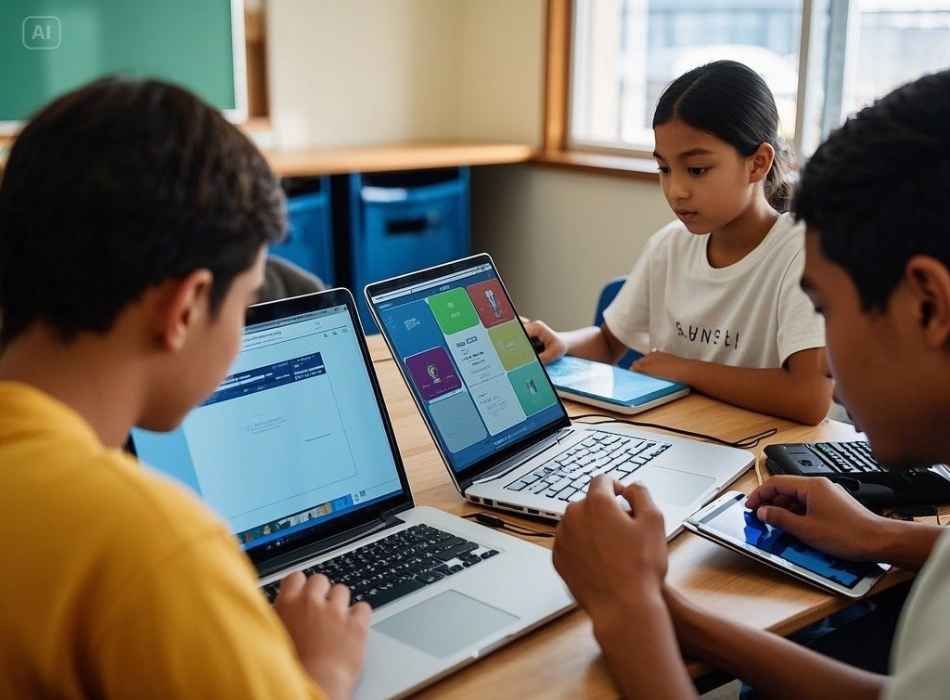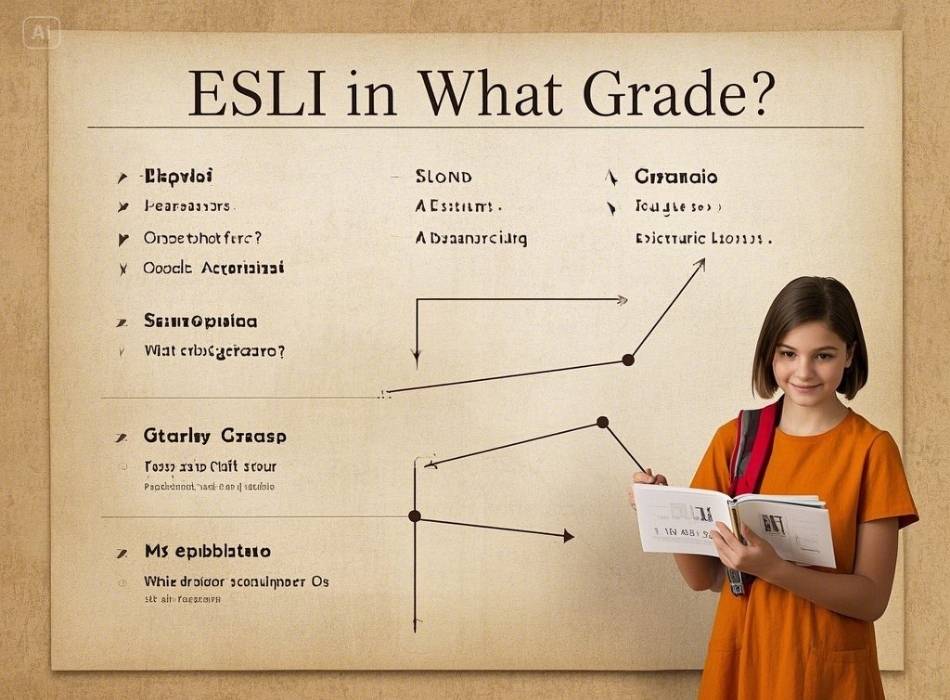If you’ve encountered ESLI (a term often seen in educational settings), you might wonder, “What grade is ESLI in?” or “How does this program integrate with traditional grade levels?” Understanding ESLI and its role in education is essential for parents, teachers, and homeschoolers seeking to support their students effectively.
This blog will explain ESLI (English as a Second Language Instruction) and its relationship to grade levels and provide guidance for supporting ESLI learners.
What Does ESLI Mean?
ESLI stands for English as a Second Language Instruction. It refers to specialized education programs designed to help non-native English speakers build proficiency in English. These programs target essential communication skills like reading, writing, speaking, and listening, enabling students to succeed in both linguistic and academic settings.
ESLI is not tied to any specific grade level. Instead, students enrolled in ESLI can span kindergarten through high school (and sometimes even higher education). Students are grouped based on their English proficiency rather than chronological age or academic grade.
Key Goals of ESLI
- Language Proficiency: Build fluency in reading, writing, speaking, and listening in English.
- Academic Success: Equip students with the language tools needed to excel in various subjects.
- Cultural Adjustment: Help students adapt to a new cultural and social environment.
Suppose your child or student is in an ESLI program. In that case, they may attend regular classes for core subjects but receive additional support or specialized ESLI sessions during the school day.
What Grade Are ESLI Students in?

Because ESLI focuses on language acquisition, the “grade” of an ESLI student is not defined by their placement in the program. Instead, their official academic grade is determined by age and previous schooling. Here’s a breakdown of how this typically works:
- Elementary School (Grades K–5)
Young learners in kindergarten or early elementary grades are usually given lots of oral language practice, learning foundational skills like vocabulary and basic sentence structures.
- Middle School (Grades 6–8)
ESLI students in these grades work on more complex grammar, writing, and presentation skills while managing the academic demands of subjects like math and history.
- High School (Grades 9–12)
High school ESLI programs focus on preparing students for college or the workforce. They emphasize academic language and critical thinking and often include support for assignments like essays and oral presentations.
Students can progress in ESLI alongside their peers in traditional grades. Their placement in ESLI is based on English proficiency, not their grade level. Once they achieve the required proficiency, they may “exit” the program while continuing in their regular grade.
Signs a Student Might Benefit from ESLI

If you’re unsure whether a student would benefit from ESLI, here are some common signs to look out for:
- Limited vocabulary in English or difficulty forming sentences.
- Struggles with reading comprehension or following directions in English.
- Difficulty in understanding classroom discussions or lectures due to language barriers.
- Challenges grasping academic materials due to language gaps, even if the student excels in their native language.
Schools often conduct language assessments to determine students’ proficiency and decide if ESLI placement is necessary.
How to Support ESLI Students
Whether you’re a parent, teacher, or homeschooler, there are numerous ways to support an ESLI student and ensure their success. Here are some tips to consider:
- Encourage English language practice: Consistency is key to learning a new language. Encourage the student to practice speaking, reading, and writing in English regularly. Please provide them with opportunities to communicate with native English speakers or participate in activities that require English language use.
- Utilize visuals and hands-on activities: ESLI students may struggle with understanding abstract concepts or complex vocabulary. Visual aids such as pictures, videos, or diagrams can help them better grasp the material. Hands-on activities like experiments or role-playing exercises can also enhance their learning experience.

- Be patient and understanding: Learning a new language can sometimes be frustrating and overwhelming. Being patient and understanding with ESLI students as they navigate their language-learning journey is essential. Encourage them, praise their efforts, and provide constructive feedback to help them improve.
- Include cultural references: Learning a new language also involves understanding its culture. Incorporating cultural references in lessons can make the content more relatable for ESLI students and broaden their knowledge of the English-speaking world.
- Encourage self-study: The classroom is not the only place ESLI students can learn English. Please encourage them to practice outside class by reading books, watching movies or TV shows, listening to music, and conversing with native English speakers.
- Provide various learning materials: People have different learning styles, and it’s essential to cater to them by providing multiple learning materials such as textbooks, online resources, worksheets, and interactive activities.
- Use real-life scenarios: Make the lessons practical by incorporating real-life scenarios that ESLI students may encounter daily. This can help them apply what they have learned in a meaningful way.
- Create a comfortable and inclusive learning environment: Creating a climate where ESLI students feel safe and accepted is essential. Emphasize the importance of diversity and respect for different cultures within the classroom.
- Encourage peer-to-peer interactions: Group activities and pair work can help ESLI students practice their language skills in a supportive setting. This also allows them to learn from each other and build friendships.
- Provide resources outside class: Share additional resources such as books, websites, or apps that ESLI students can use to practice English outside class. This will encourage continuous learning and improvement.
- Celebrate Progress: Acknowledge each student’s Progress and celebrate their achievements, no matter how small. This will boost their confidence and motivation to continue learning.
- Be patient and understanding: Learning a new language can sometimes be challenging and frustrating. Be patient with your ESLI students and offer support when they are struggling. Understanding their difficulties and providing extra guidance can significantly impact their learning journey.
- Incorporate cultural discussions: Learning English also involves understanding the culture of its native speakers. Discuss customs, traditions, holidays, and other cultural aspects in your lessons to provide a more well-rounded learning experience for your ESLI students.
- Encourage language exchange: Encourage your ESLI students to participate in language exchange programs where they can practice speaking with native English speakers. This will improve their speaking skills and allow them to learn more about the culture and connect with others.

- Utilize technology: Take advantage of technology and incorporate it into your lessons. Many online resources and apps, such as interactive games, audio recordings, and virtual language exchange platforms, can enhance the learning experience for ESLI students.
- Incorporate cultural lessons: It is essential to incorporate cultural lessons into your curriculum and teach English language skills. This will help your students better understand the customs, traditions, and social norms of English-speaking countries.
- Create a supportive classroom environment: Creating a safe and supportive classroom environment for ESLI students is essential. This means promoting inclusivity, respecting different cultures and backgrounds, and encouraging open communication.
- Provide opportunities for peer collaboration: Collaborative learning is beneficial for ESLI students as it allows them to practice their English skills in a non-threatening environment. Encourage group work, pair work, and project-based learning activities.
- Incorporate technology: Technology can be a valuable tool for ESLI students. Use online resources, multimedia materials, and language learning apps to enhance the learning experience.
- Assess and provide feedback regularly: Regular assessments are necessary to track the Progress of your ESLI students. Provide constructive feedback that focuses on their strengths and helps them improve their weaker areas.
- Encourage self-directed learning: Besides traditional classroom instruction, encourage ESLI students to take charge of their education outside class. This could include reading English books, watching English movies, or practicing with language-learning apps.
- Create a supportive classroom environment: ESLI students may feel intimidated or self-conscious about speaking in front of others. Create a safe and supportive classroom environment where they feel comfortable making mistakes and asking for help.
- Incorporate cultural awareness: ESLI students need to learn the English language and understand the culture of native English speakers. Incorporate activities that promote cultural awareness and understanding.
- Stay up-to-date with teaching strategies: As an ESLI teacher, it is important to constantly update your teaching strategies and techniques. Attend workshops, conferences, and professional development courses to stay current and improve your skills.
1. Encourage Language Practice

- Engage students in conversations to improve their speaking confidence.
- Please encourage them to read books, watch shows, or play games in English to enhance comprehension.
2. Provide a Comfortable Learning Environment
Creating a welcoming and inclusive atmosphere can help ESLI students feel more comfortable participating and asking questions.
3. Partner with Educators
Teachers and ESLI instructors can offer valuable insights into a student’s Progress and share tailored strategies to reinforce language learning at home or through supplemental activities.
4. Use Resources Designed for ESL Learners
Platforms like Duolingo, which gamifies language learning, or Raz-Kids, which provides leveled reading resources, can be excellent tools for practice.
5. Celebrate Progress
Learning a new language takes time. To boost confidence, students should recognize and celebrate even small milestones in their language acquisition.
FAQs About ESLI
Q1. How long do students stay in ESLI?
The length of time a student remains in ESLI depends on their Progress. Some students might exit the program in 1–2 years, while others may require longer. Regular language assessments help determine their readiness to transition out of the program.
Q2. What happens when a student exits ESLI?
Once students demonstrate the required English proficiency, they transition out of the program to fully integrate into mainstream classes. Some schools offer continued support to ensure a smooth transition.
Q3. Does ESLI affect grade progression?
No. ESLI supports language development while students continue in their designated academic grades. ESLI placement is independent of grade-level advancement.
Q4. Can homeschooling families implement ESLI strategies?
Yes! Homeschooling families can integrate ESLI approaches by utilizing the ESL curriculum and tools like Rosetta Stone and incorporating daily speaking and reading practice.
Q5. How can schools assess whether a student needs ESLI?
Most schools use assessments like the WIDA ACCESS test or other English language proficiency screening tools when students enter the school system.
Why ESLI Makes a Lasting Impact
ESLI programs support non-native English speakers as they adapt to their educational environments. By focusing on language proficiency and providing targeted support, ESLI helps students build skills that extend far beyond the classroom.
Partnership, patience, and persistence are keys to success for parents, educators, and homeschoolers alike. ESLI isn’t about categorizing students into grades; it’s about equipping them with tools to thrive academically and socially throughout their education.
Whether you’re considering ESLI placement for a child or looking to enhance the language-learning experience for your students, fostering a supportive and consistent environment can make all the difference.
Conclusion
The ESLI approach empowers students to master language skills while fostering confidence and adaptability. By creating an environment built on collaboration and understanding, we can help learners unlock their full potential and achieve lasting success. Together, we can shape a brighter future for every student, one word at a time.











